One of the unique characteristics of banh duc is its simplicity. The dish only requires a few basic ingredients, but the combination of flavors and textures is what makes it so appealing. Banh duc is also a versatile dish that can be enjoyed as a main course or as an appetizer.
What is banh duc?
Banh duc is a traditional Vietnamese dish that has been enjoyed for centuries. It is a type of steamed rice cake made from rice flour and water, which is then shaped into a solid block or molded into a cup-like shape. Banh duc is often served with a variety of savory toppings such as shredded chicken, fried shallots, scallions, and fish sauce.
3 main types of banh duc:
- Banh duc man (or banh duc tom chay) / Steamed coconut rice cake with dried shrimp: This is a savory banh duc that is often made with a mixture of rice flour, coconut milk, and dried shrimp or ground pork. It is usually served with a spicy and tangy dipping sauce, and the combination of flavors and textures is what makes it so delicious.
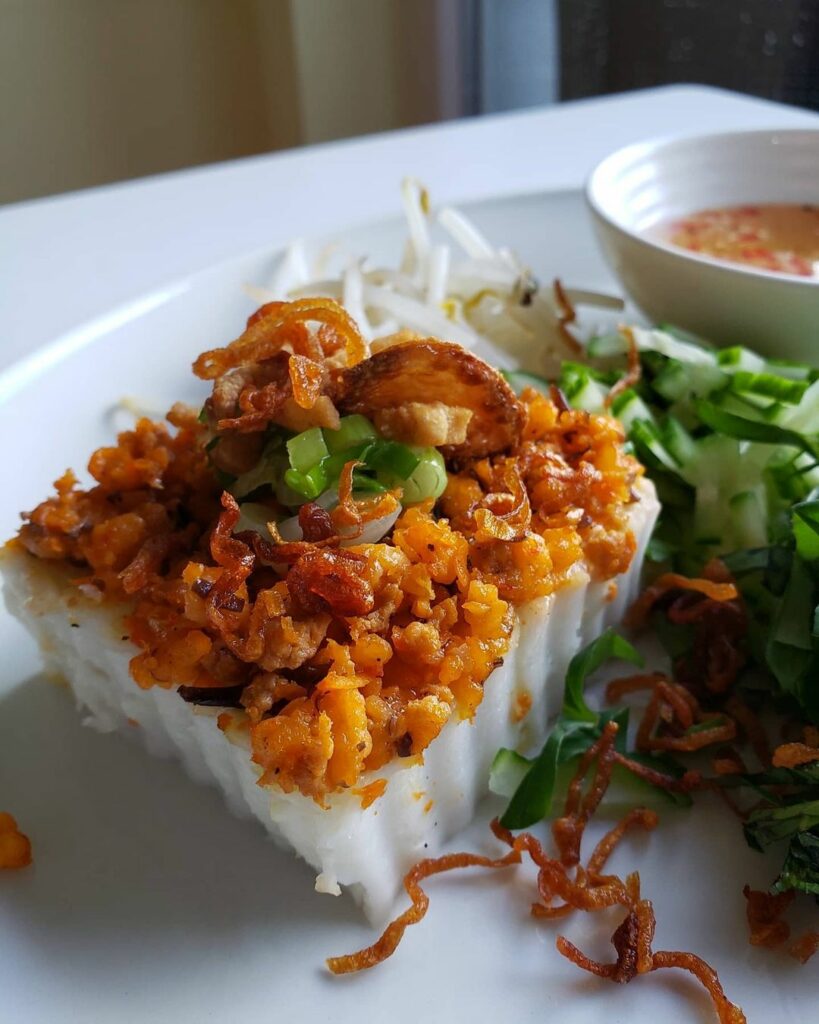
- Banh duc nong / Steamed rice cake with toppings: This is a simple but satisfying version of banh duc that is often served hot and topped with a variety of ingredients such as scallions, fried shallots, and chopped peanuts. It is typically eaten as a popular Vietnamese snack or light meal, and the warmth of the dish makes it especially comforting on cold days.
- Banh duc la dua nuoc cot dua / Pandan rice cake with coconut milk: This is a sweet version of banh duc that is made with pandan leaves and coconut milk. It has a slightly chewy texture and is often served with a sweet coconut milk sauce that complements the flavors of the pandan and rice flour.
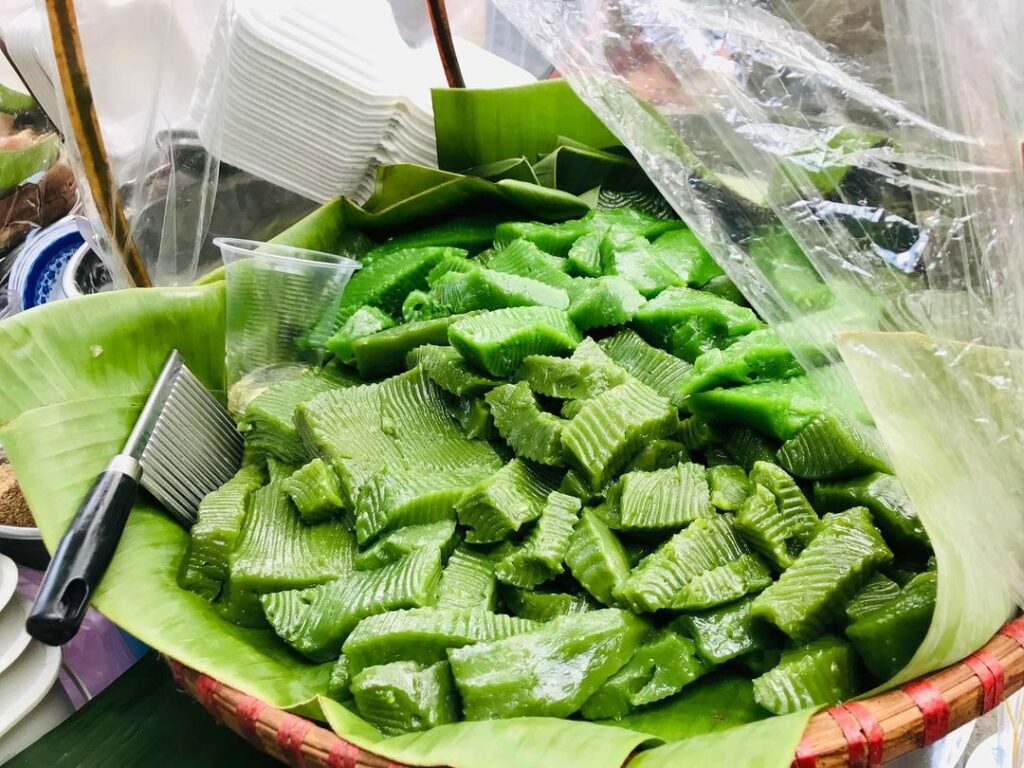
In addition, there are several other types of banh duc that you may want to be familiar with. These include banh duc mien bac, banh duc nguoi hoa, and banh duc khoai mon tom thit.
Overall, banh duc is a versatile and delicious dish that comes in many different varieties. Whether you prefer savory or sweet, hot or cold, there is a type of banh duc out there for everyone to enjoy.
Banh duc recipe
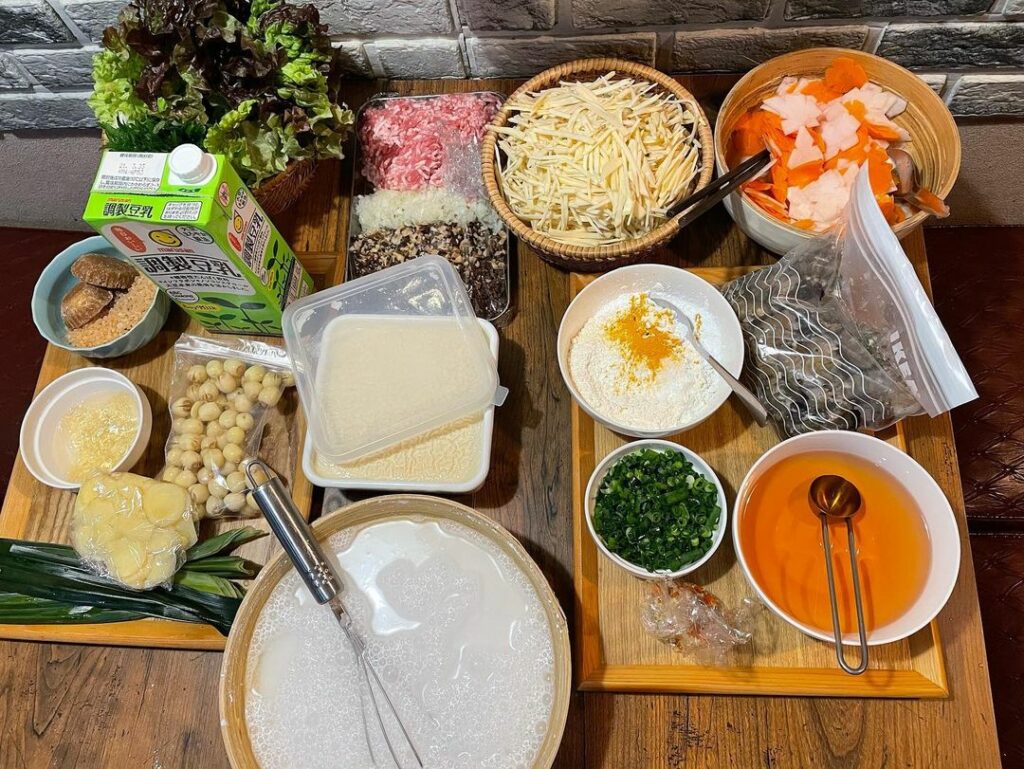
Cooking notes
- Yield: 4-5 people
- Prep time: 15 minutes
- Cook time: 20 minutes
- Total time: 35 minutes
- Course: Appetizer or Main dish
- Cuisine: Vietnamese
Ingredients and tools needed
For banh duc and toppings
- 100g rice flour
- 50g tapioca starch
- 200g ground pork
- 1/2 onion, finely chopped
- Fried shallots
- 3 wood ear mushrooms, sliced
- Coriander, scallions
For the sauce
- 500ml bone broth (can use chicken or pork bones)
- 1 tablespoon vinegar
- 1 tablespoon sugar
- 2 tablespoons fish sauce
- Black pepper
- Salt
- Chili, vinegar, sugar, fish sauce, or lime juice for seasoning (if desired)
Equipment
- Mixing bowl: to mix the rice flour, tapioca starch, and water together to make the dough.
- Pot: to cook the dough and the broth.
- Spoon: to scoop out small portions of the dough and drop them into the boiling water.
- Knife: to chop the onion and slice the mushrooms.
- Cutting board: to chop the onion and slice the mushrooms.
- Ladle: to pour the hot broth over the banh duc nong when serving.
- Bowl: to serve the banh duc nong and broth.
How to make banh duc?
- In a large mixing bowl, combine the rice flour and tapioca starch. Gradually add in 350ml of water while mixing until the mixture is smooth.
- In a separate bowl, mix together the ground pork, chopped onion, and sliced mushrooms.
- Pour the rice flour mixture into a pot and add in the pork mixture. Stir well to combine.
- Bring the pot to a boil over medium heat, stirring constantly to prevent the mixture from sticking to the bottom of the pot. Cook for about 15 minutes until the mixture thickens and becomes a sticky dough.
- Using a spoon, scoop out small portions of the dough and drop them into a pot of boiling water. Cook for about 3-4 minutes until the dough becomes firm and slightly chewy.
- To make the broth, bring the bone broth to a boil in a separate pot. Add in the vinegar, sugar, fish sauce, black pepper, and salt. Stir well to combine.
Tips:
When cooking the dough, it’s important to pay attention to the heat of the stove. If the dough is too thick, you should use low heat. Use a wooden spoon to stir the dough and a steamer to evenly spread the mixture for a smoother texture.
Some typical Vietnamese dishes made from rice flour that you should also try are
- Banh Beo – Vietnamese Steamed Rice Cakes
- Vietnamese Banh Bot Loc Recipe
- Vietnamese Banh Uot – Steamed Rice Rolls Recipe
- Banh Trang Tron – Vietnamese Rice Paper Salad
How to serve Banh duc nong?
Banh duc nong can be served in a variety of ways, depending on your preferences. Here are a few common ways to serve banh duc nong:
Serve hot: Banh duc nong is best enjoyed hot, so make sure to serve it immediately after cooking. This will ensure that the texture is perfect and that the flavors are at their best.
Toppings: Banh duc nong is often served with a variety of toppings, such as fried shallots, sliced scallions, coriander, and chili peppers. These toppings can be added to taste, depending on your preferences.
Broth: Banh duc nong is often served with a hot broth that is poured over the top of the rice cakes. The broth can be made with pork bones, chicken bones, or vegetables, and can be seasoned with fish sauce, salt, sugar, and vinegar to taste.
Dipping sauce: Some people like to serve banh duc nong with a dipping sauce made from fish sauce, lime juice, sugar, and chili peppers. This sauce can be adjusted to taste, depending on your preferences.
How to select the right ingredients for banh duc nong?
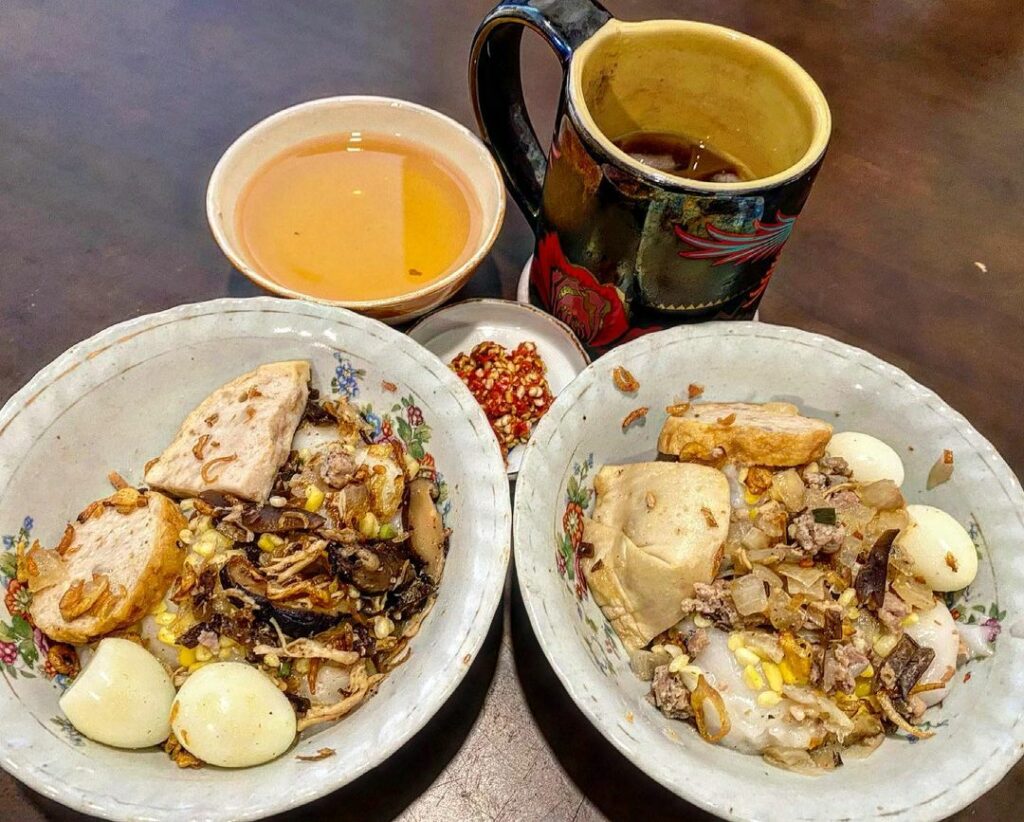
Here are some tips on how to choose high-quality ingredients for making banh duc nong:
Choosing good quality pork
- It is best to buy whole pieces of pork and grind them yourself using a meat grinder to ensure safety and quality when using it in your recipe.
- Fresh pork should have a firm texture and good elasticity. You can press the meat with your fingers to check whether it leaves an indentation or sticks to your hand. Fresh pork should not do either of these.
- Fresh pork should have a bright red or deep red color and a dry exterior.
- Avoid purchasing pork that appears gray, brown, or has a dull color, has a bad smell, or has signs of being slimy. These are all signs that the meat is spoiled.
- Be careful to avoid pork that has been raised with nitrates or other harmful additives. This type of pork will have a darker color, reddish spots on the skin, and a stronger, unpleasant smell compared to clean pork.
Choosing good quality wood ear mushroom
- Choose cloud ear fungus with large, thick ears and few small ears.
- Good quality cloud ear fungus should have a deep, shiny reddish-brown color and a pale coffee-colored underside.
- Avoid selecting cloud ear fungus with black spots or signs of mold.
Choosing good quality wood ear mushrooms
- Select wood ear mushrooms that are not broken or snapped, with a dark brown or light color.
- Avoid selecting wood ear mushrooms with a strange smell or white mold.
Nutrition facts of banh duc nong
Serving size: 1/5 of recipe (about 200g)
- Calories: 232
- Total Fat: 9g
- Saturated Fat: 3g
- Cholesterol: 34mg
- Sodium: 427mg
- Total Carbohydrates: 28g
- Dietary Fiber: 1g
- Sugar: 1g
- Protein: 11g
Note that these are only approximate values and may vary depending on the specific ingredients and cooking methods used. Additionally, the toppings and broth used can also contribute to the overall nutrition of the dish.
Common mistakes to avoid
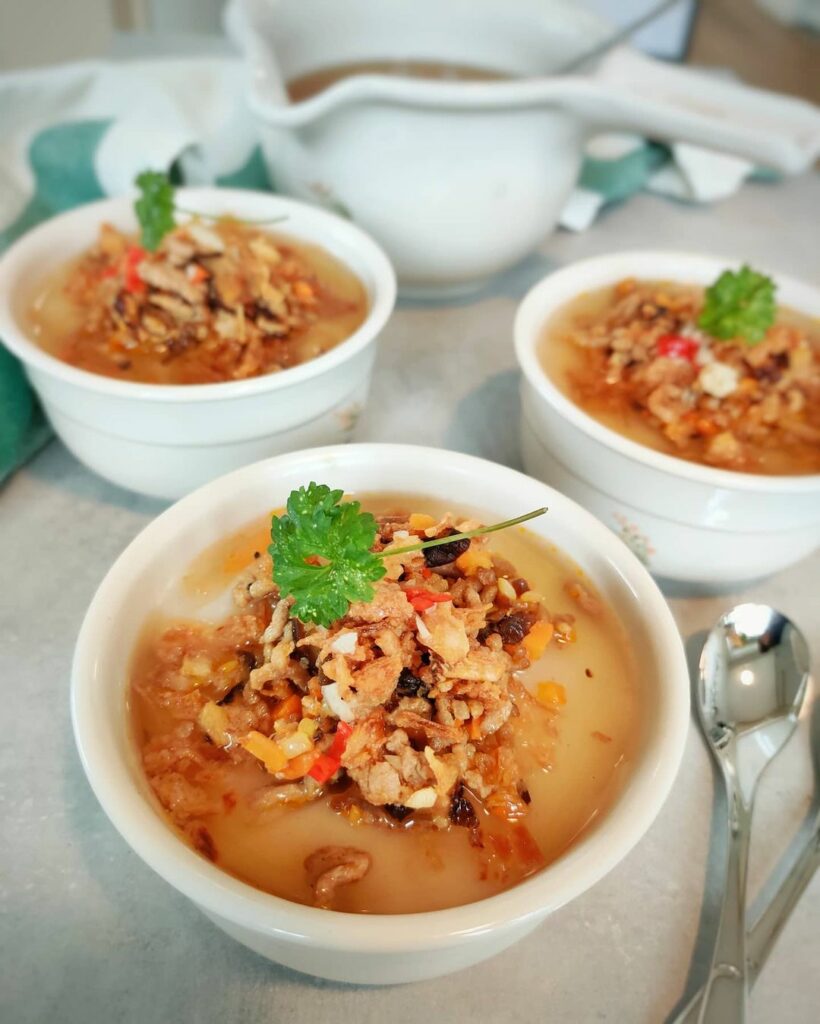
Making banh duc nong can be a bit tricky, especially if you’re new to the recipe.
- Using the wrong ratio of rice flour and tapioca starch
- Not stirring the mixture enough
- Using cold water
- Using too much or too little water
- Cooking the banh duc nong for too long or too little
- Not seasoning the broth properly
- Not adding enough toppings
FAQs
Why people like to use lime and borax in their Banh duc nong?
It is a common practice in some regions of Vietnam to add slaked lime (vôi – Calcium Hydroxide) and borax (sodium borate) to the banh duc nong recipe. These ingredients are believed to help make the banh duc nong more chewy and elastic. However, the use of these ingredients is not necessary and some people prefer to make banh duc nong without them.
Is banh duc nong gluten-free?
Yes, banh duc nong is gluten-free since it is made from rice flour and tapioca starch.
How to store banh duc nong?
To store banh duc nong, wrap the leftovers tightly with plastic wrap or aluminum foil and store them in the refrigerator. When you want to eat them again, you can reheat them by steaming or microwaving them in a covered container until they are heated through. It’s important to cover the banh duc nong tightly to prevent it from drying out or absorbing any unwanted odors in the refrigerator.
What if my banh duc dough is too loose and runny?
If your banh duc dough is too loose and runny, it may be difficult to store it in its current state. The best option is to try to adjust the consistency of the dough by adding more rice flour or tapioca starch to thicken it up. Once you have adjusted the consistency to your liking, you can wrap the dough tightly in plastic wrap and store it in an airtight container or freezer bag in the refrigerator for up to 2 days or in the freezer for up to 1 month. When you are ready to use the dough, allow it to come to room temperature before shaping and steaming the rice cakes.
Can I make banh duc nong ahead of time?
Yes, you can make banh duc nong ahead of time. Once the rice cakes have cooled to room temperature, store them in an airtight container in the refrigerator for up to 3 days. To reheat, steam the rice cakes for a few minutes until heated through. If you need to make them even further in advance, you can freeze them for up to 1 month. To thaw, place the banh duc nong in the refrigerator overnight and then reheat by steaming.
Conclusion
Banh duc nong is a delicious and comforting Vietnamese dish that is loved for its simple yet satisfying flavors and texture. With its soft and chewy rice cake base and savory pork and mushroom filling, it’s a dish that’s perfect for any meal of the day. Making banh duc nong can take some time and effort, but with the right ingredients and techniques, it’s a dish that’s definitely worth the effort. Whether enjoyed fresh or reheated, banh duc nong is sure to warm you up and fill you up with its deliciousness.